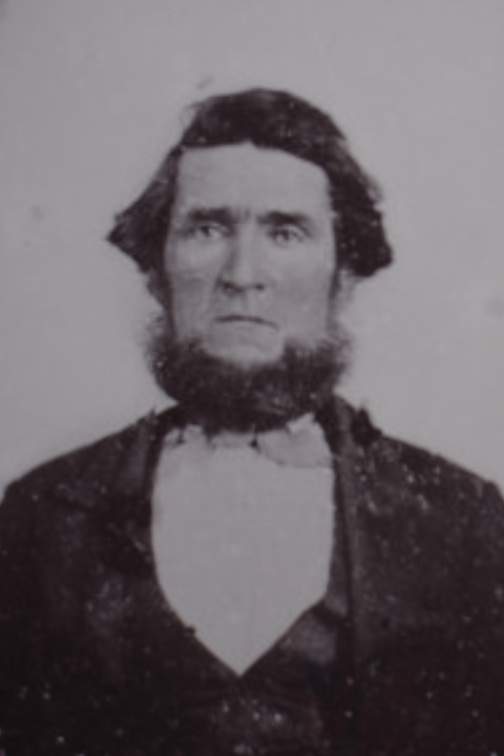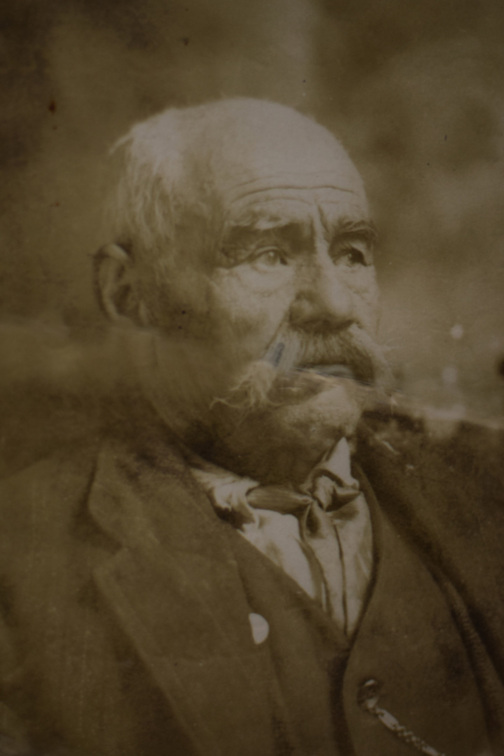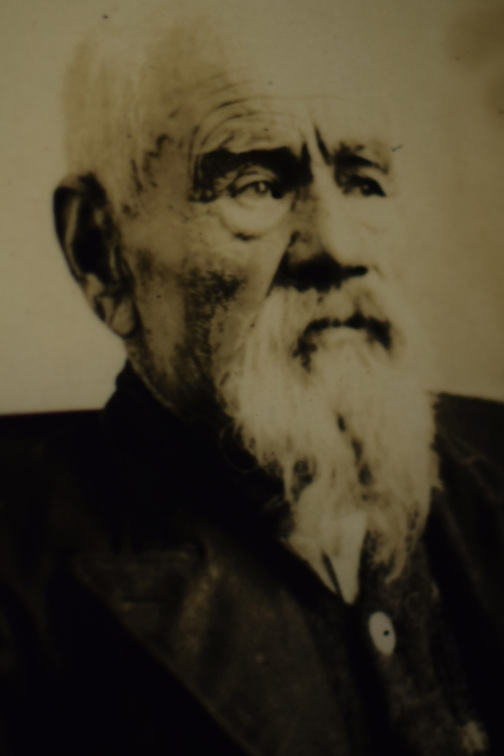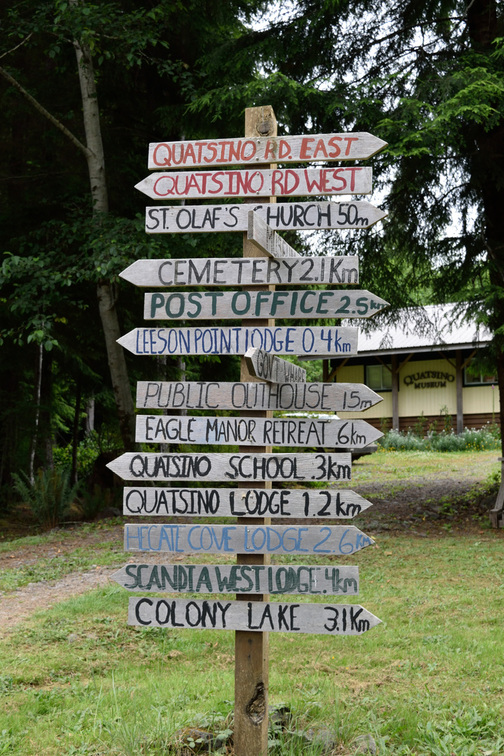I’d like to give a special thanks to three people for helping me with this post: Gwen Hansen of the Quatsino Museum and Archives for providing historical information on Ed Frigon; Jane Hutton of the Port Hardy Museum and Archives for allowing me to photograph images of Ed Frigon and his hotel; and, my friend and friendly neighbour, Evelyn Hartford, for providing me with a photograph of Frigon’s hotel, articles and for being a general all round valuable resource for historical information on the North Island.
July 19, 2016
We wanted to go out on Neroutsos Inlet to Drake Island where the notorious Ed Frigon had his hotel and trading post between 1895 and 1917. We had been talking about the idea for a while. It took some convincing to get James on side for it: he thought our kayaks wouldn’t be big enough to carry all the stuff we needed. We finally concluded it shouldn’t be that hard, since many have paddled all the way around the Island with just their kayaks for carrying supplies…for a good stretch anyway. As it turned out, after paring down a few items, there was plenty of room for what we needed. Sea kayaks are big kayaks.
Ed Frigon is one of Port Alice’s favourite historical “characters.” The very picturesque islands on Neroutsos Inlet are named after him. Frigon was an entrepreneur, an adventurer and a man with a mind of his own. He also had several wives, though not all at the same time.
Ed or “Ned” Frigon was born in Maurice, Quebec. At the age of 21 he left his family to find riches in the California Gold Rush of 1848-55. He took a boat to Panama, then crossed the isthmus by foot through mud, swamps, tropical heat by day and swarms of mosquitos by night. Making it to the Pacific coast in a little over a week, he took passage on a schooner to San Francisco. Although he managed to find gold, it was never enough to overcome the overinflated living costs in the area. He left the mines in disgust. He worked for a time in the San Francisco Bay area; then, not happy with the warm climate, he headed further up the coast. He eventually landed in Victoria, BC. In 1857, after accumulating a tidy savings, he headed to Hope Island on the north end of Vancouver Island to be a fur-trader.
Frigon was one of the first few white men to live among the local Indigenous population. He appeared to get along well with them; but, from time to time, a few “cultural disparities” would emerge.
The material goods in his store could incite envy in people who knew nothing but living off the land. A small group of unscrupulous men once plotted to kill him and divide his goods among themselves. Forewarned by his Indigenous wife at the time, the night of the planned attack he locked all the doors and windows and slept with several loaded weapons by his bed. It turned out that the locked door was enough to thwart the plan.
The next day Frigon opened his store and behaved as if nothing had happened, but had a message sent to the authorities in Victoria. A few weeks later a gunboat appeared, heading in the direction of Hope Island. Upon landing, the commander of the vessel warned the First Nations community that they would be punished should anything ever happen to Ed Frigon. After seeing many Indigenous communities decimated by the colonists, they considered this a serious threat. Thereafter, Frigon was accompanied by an entourage of Indigenous bodyguards wherever he went, to the point it became a serious encumbrance to him.
Of Ed Frigon’s many wives, most of them were Indigenous. He outlived some, was deserted by others and had to send at least one back to her people. Although Frigon was believed to be monogamous, he had a certain charm with women. One of his wives, who was the jealous type, tried to stab him with a butcher knife while he was in his bed. As she raised the knife to deliver the fatal blow, Frigon grabbed her wrist and said, “Not tonight Marie!” He removed the knife from her hand and threw her out of the house. It was with some regret, as he thought she was a very good housekeeper and “une dame belle.”
Frigon carried on trading on Hope Island until 1889, then built a second trading post at Korprino Harbour. In 1895 he moved to Quiet Cove, (Pamphlet Cove) on Limestone Island (now Drake Island) where he built a store, hospital, steamship stop and hotel with a saloon that had the ‘longest bar north of San Francisco.’ When rumours of prohibition were about, Frigon sold his hotel to the mill in 1917. He retreated to a large property north of Port Alice to live with his last common law wife, Lucy Moon. Lucy Moon had the title of “The Last of the Long Heads”: she was the last member of a group of Indigenous people who bound the heads of their children to elongate them. The hotel was floated down to Port Alice where it became a boarding house for mill workers, called “Jones’ Hotel.”
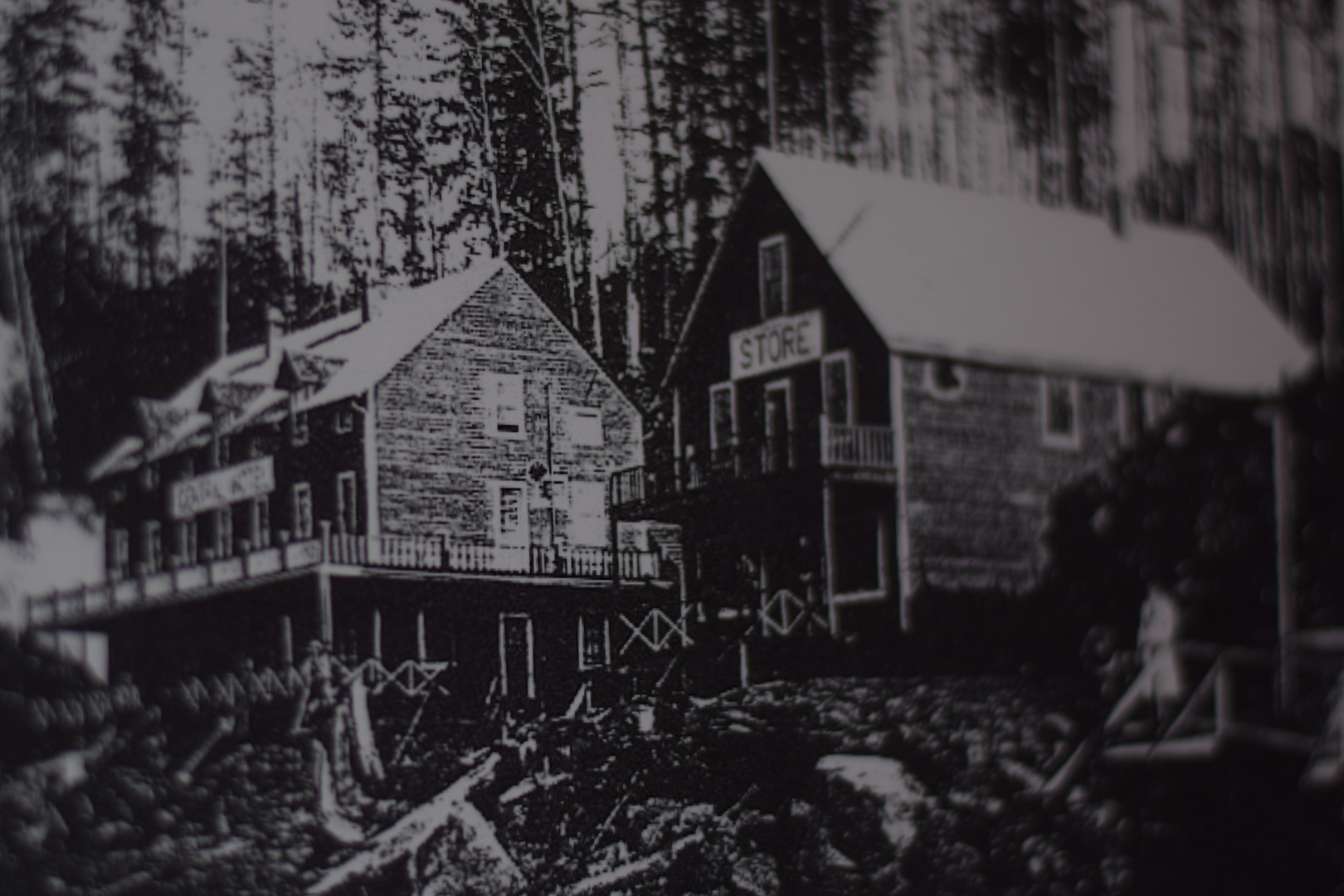

To get to Drake Island we ended up launching from Atkin’s Cove, a place we had been to before. To get there you take Neroutsos Main north of Port Alice on the east side of Neroutsos Inlet. Keep going on Neroutsos Main for 12 kilometres. Make sure to keep a careful eye on your odometer—it might be the only way you’ll be able to find the proper turn. About halfway there you will see a fork in the road with a branch that goes up the mountain. Don’t take it. That’s Quarry Main. It won’t take you to Atkin’s Cove, but it will take you up the mountain for an incredible view! Go up too far and you will definitely be needing a four-wheel drive and a strong stomach for driving on high mountain roads! Once you pass a side road on Nertoutsos Main with a wire across it, go a few metres further and turn left along a little “goat trail” that’s just wide enough for a vehicle to pass. Sometimes it is overgrown with shrubs, but sometimes it’s brushed. Drive for about a half a kilometre to a pull-out where you can park. In total, you shouldn’t go over 13 km from Port Alice. Any more than that and you’re lost! Let me remind you that if you go out into the bush, make sure to inform someone where you’re going and when you plan to be back so you don’t have to wait for days or even weeks before someone realizes you are missing.
If you look hard enough, on the south west side of the pull-out, you will see an opening in the shrubs which should be marked with florescent ribbon. That is the trail head. If you walk into the woods to the west, you will start to see water. If you read about our first adventure to Atkin’s Cove from years back, you will see how we got terribly lost! Check out my post, “Atkin’s Cove: Lost and Lost Again!” and have a laugh!
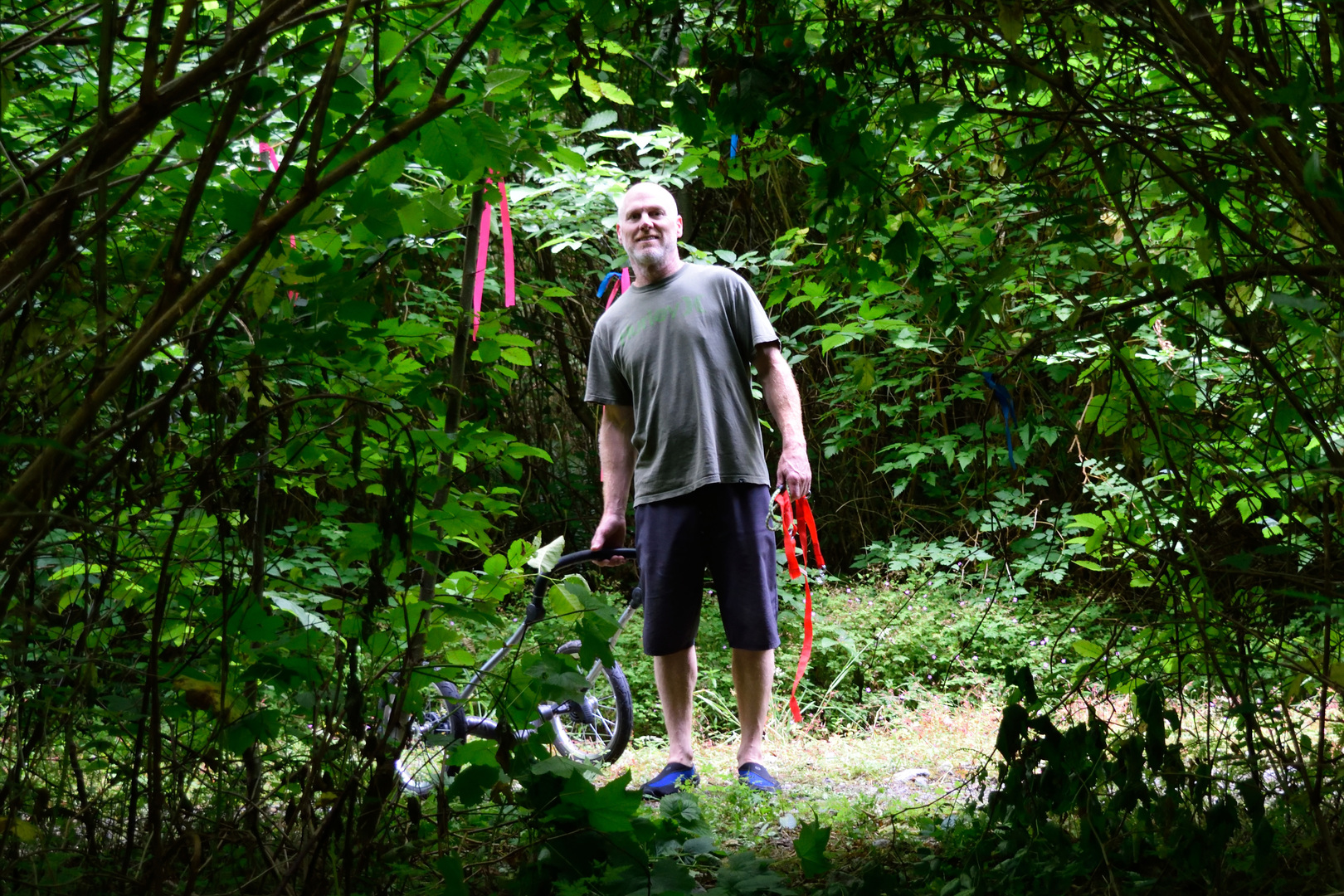
James and I were originally going to launch at Kokwina Cove (which is a little portage to the east of the goat trail) that is at the edge of the Quatsino Narrows with all its nasty currents. We were going to time the tides to go out just before slack tide. I was apprehensive about the idea but didn’t say anything. Then, out of the blue, James voiced misgivings. I told him that if he’s uncertain, then I’m scared you-know-what-less! We talked about it some more, then concluded there were too many unknowns. We decided to take Atkin’s Cove to Drake Island instead. I said I would be willing to try Kokwina some day, but not with Chloe.
You could also get to Drake Island by launching from Port Alice, but it would be a minimum two-day trip. If you are a strong paddler, you may be able to make it to Drake Island in one day. If not, you could spend the night at Atkin’s Cove. Make sure to time the tides, so they are carrying you in the direction you want to go. Leave early in the morning before daytime heating makes the water on Neroutsos Inlet too choppy.
We dragged our supplies and kayaks down the hill to our launch point. Chloe was excited about getting into a kayak. As soon as I put a couple of blankets in her cockpit, she hopped in and wouldn’t leave!
The camera box only fits comfortably in the tandem Manitou; but, because I was due for surgery and James is so noble, he felt he had to paddle the heavier loaded down kayak. It ended up that I only had James’ phone—that doesn’t have a neck strap—for taking photos. I didn’t have much trouble paddling the larger kayak, but he insisted. It would turn out to be something he would woefully regret!
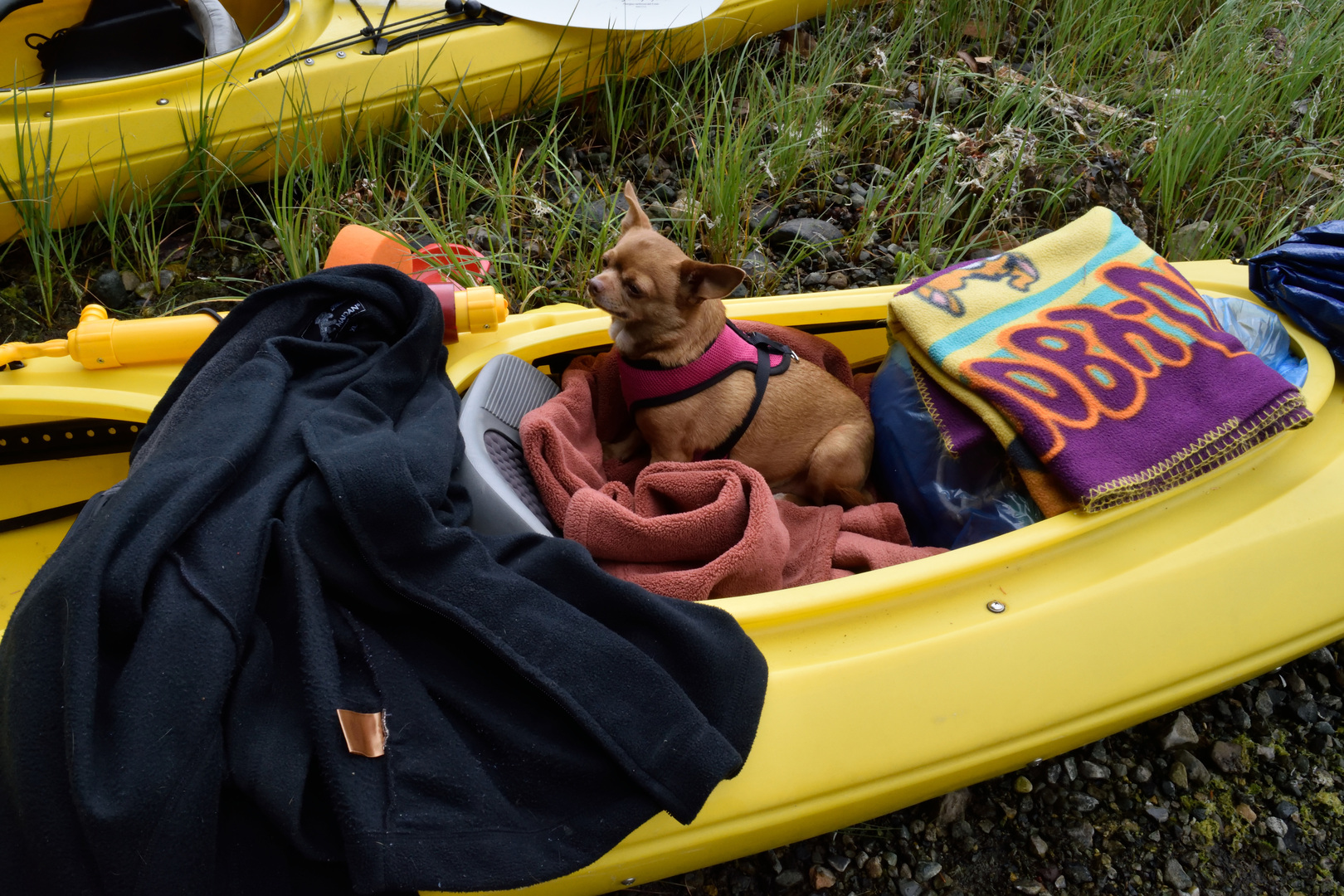
After leaving the tranquil calm waters of the cove, we met the rougher waters of Neroutsos Inlet—which were especially rough around the point! We made it around somehow, riding waves that made our kayaks feel like bucking broncos!
As soon as we came around the point to calmer waters, we met a community of Harbour seals—one with a baby—playing peek-a-boo with us.
When we crossed the inlet to the east side of Drake Island, our stomachs started complaining. It was 3 o’clock and we had only had breakfast. We landed briefly for a snack. Although we were on Drake Island, we still had a considerable paddle to get to Pamphlet Cove. As we paddled around the large island, we were getting impatient. We kept saying, “are we there yet?” It took a while, but we finally got there!

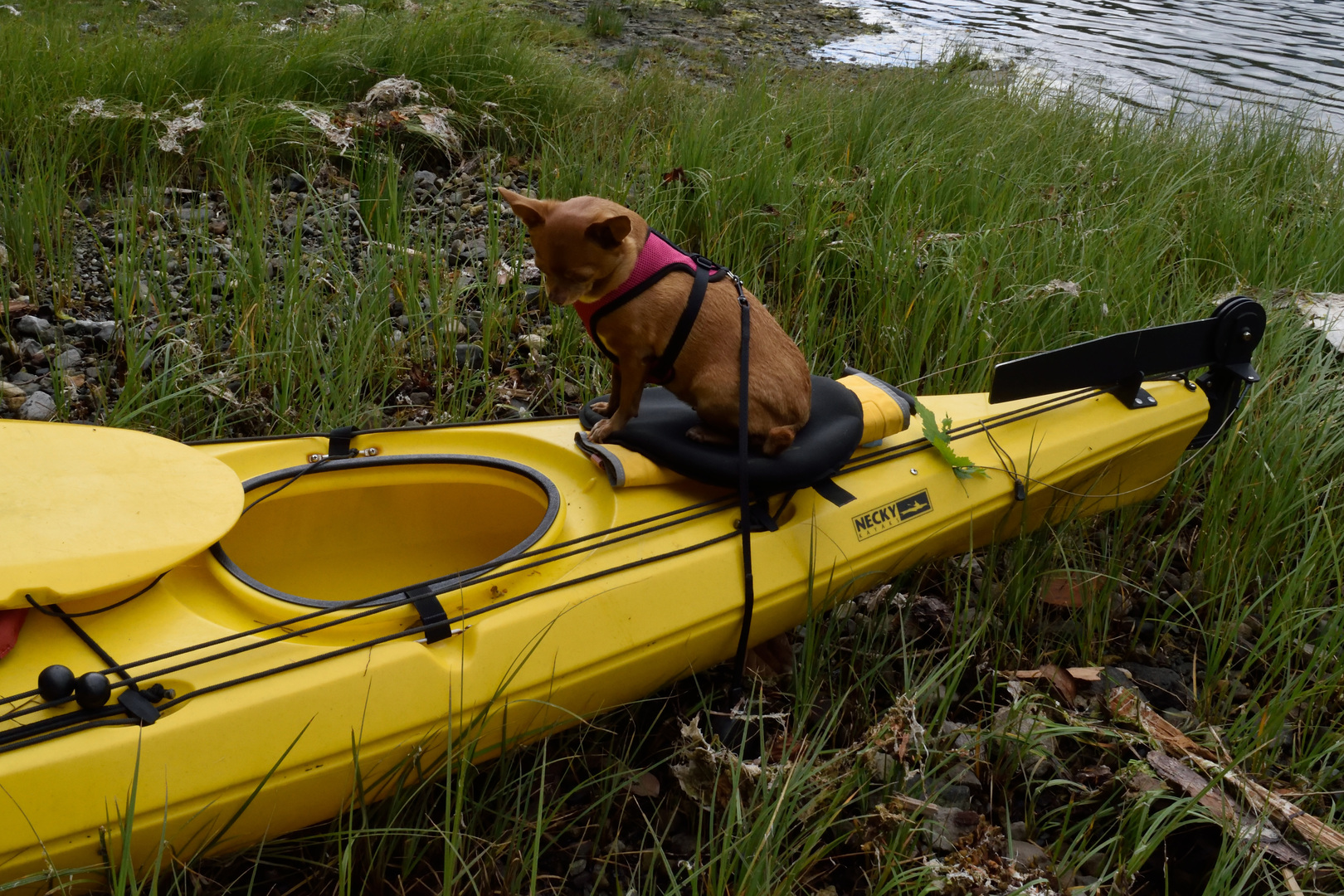

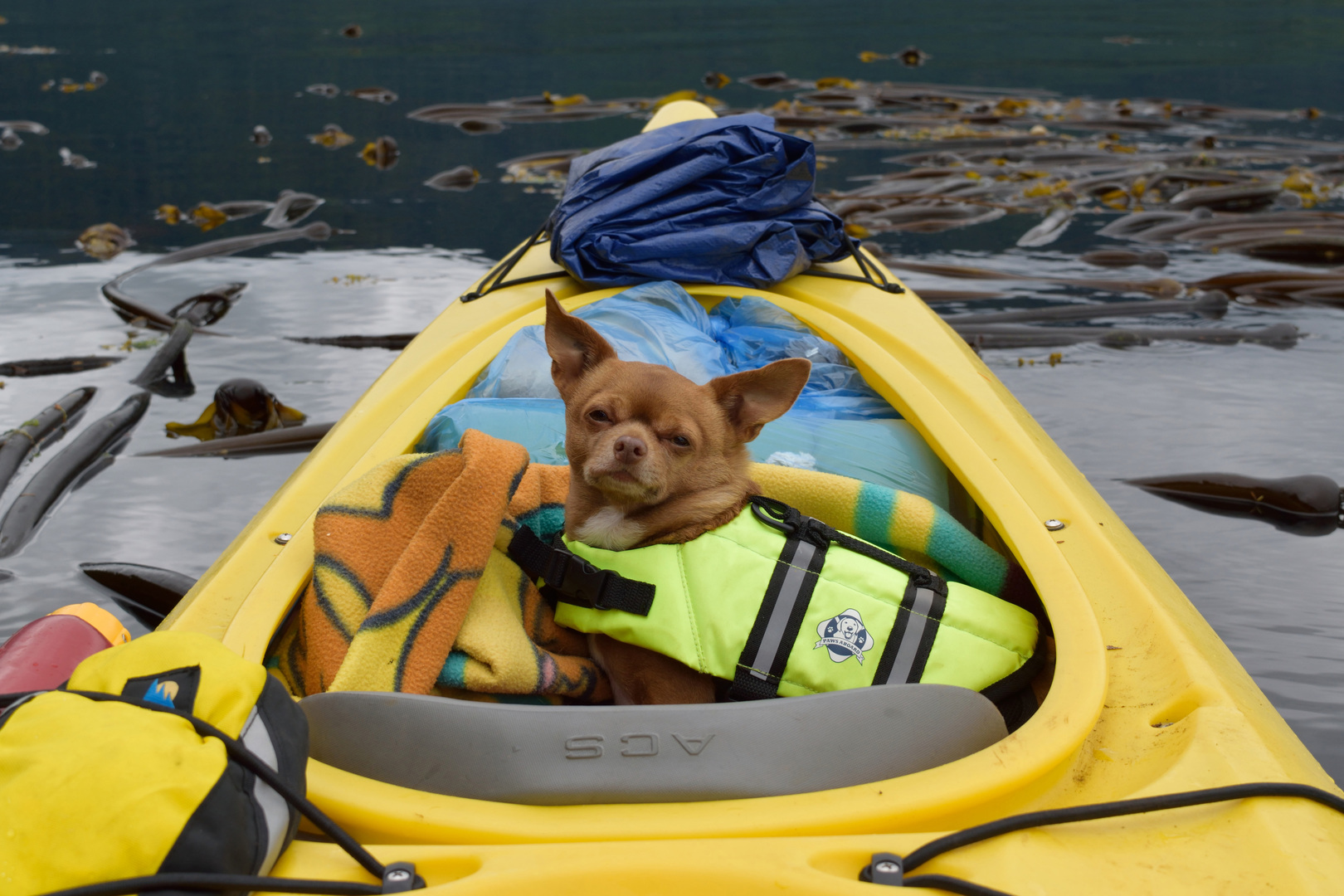
Coming up on the entrance of Pamphlet Cove, we entered a serene, windless, warmer, almost stagnant zone of the Sound. The water was calm, with bits of flotsam and foam floating on top. At the entrance of the cove were a couple of rock protrusions with bonsai-like trees on top. It made me think of a water-bound Japanese garden.

We came across a sign surrounded by foxgloves. It informed us that the foxgloves marked the location of Ed Frigon’s hotel! That was the only sign of the previous human habitation, as the area had been almost completely reclaimed by the forest.
Before landing, we decided to explore the cove in our kayaks. The tide was ebbing out, but there was still enough water left for us to go in quite far. We saw lots of little fish. The cove is apparently a haven from the big fish of the sound. All the racing and roaring of the ocean was blocked out. Our voices and splashes echoed against the trees. James was well ahead of me, looking around and lost in wonderment. Unfortunately, that wonderment would be short-lived…
As I passed the shallow channel between the two sections of the hourglass shaped cove, I found a beautiful arrangement of three large starfish sitting together on some large rocks just below the surface of the rushing water. I snapped pictures like crazy! I was obsessed! I don’t know what it is with me a starfish, but they make me go bonkers! I envisioned making some serious money from the shot!
The current was strong and made it hard to stay still long enough to snap the photos. I kept putting James’ cell phone on my lap as I paddled frenetically. I took tons of pictures but kept wanting that one extra picture! When I started to put the camera away after that last extra, extra shot, as I transferred it from one hand to another, it did a sudden flip—as if someone or something had tried to reach out and grab it—then, plop!, into the water it went!
I screamed! I almost went in headfirst trying to reach for it. I tried to stay at the spot where it fell, so maybe we could somehow find it. I kept calling for James, but he wasn’t coming. I called again a couple of times. He finally showed up.
“What’s up?” he asked. I told him I dropped his phone in the water. He said, “you’re joking, right?” I shook my head in the negative. Again, he said, “You are joking?” I shook my head again.
We repeated that little interchange a couple of times more until he started to make the paradigm shift and acquire a very startled look.
I told him I was over the spot where it fell. In a frenzy, he got out of his boat in the shallow water, rolled up his shorts up to his hips and walked onto the rocks, frenetically searching and reaching in the water for his phone.
Feeling what we feel, Chloe, in the Manitou, was whining desperately. It took some time, but James finally found the camera. It was standing upright in a space between two rocks—which was why it was so hard to find.
With the phone retrieved, we paddled mournfully to our camping spot. I was slouched in the Eskia, paddling a good distance behind and giving James plenty of space. Needles to say, when we landed, he didn’t help me out of my kayak as he usually does.
After about an hour, James was back to his old self and being very poetic about the whole thing. He said it was bound to happen sooner or later. The very nature of cell phones is that they easily get damaged and lost, simply because they are not wired to a wall.
We landed in the area were Ed Frigon’s old floating wharf used to be. All that was left was a construction of poles covered with barnacles embedded in a very mucky shoreline. Half hidden in the trees was an upside-down boat, weathered, worn, with a couple of gaping holes in the bottom—definitely no longer sea-worthy!
.JPG)

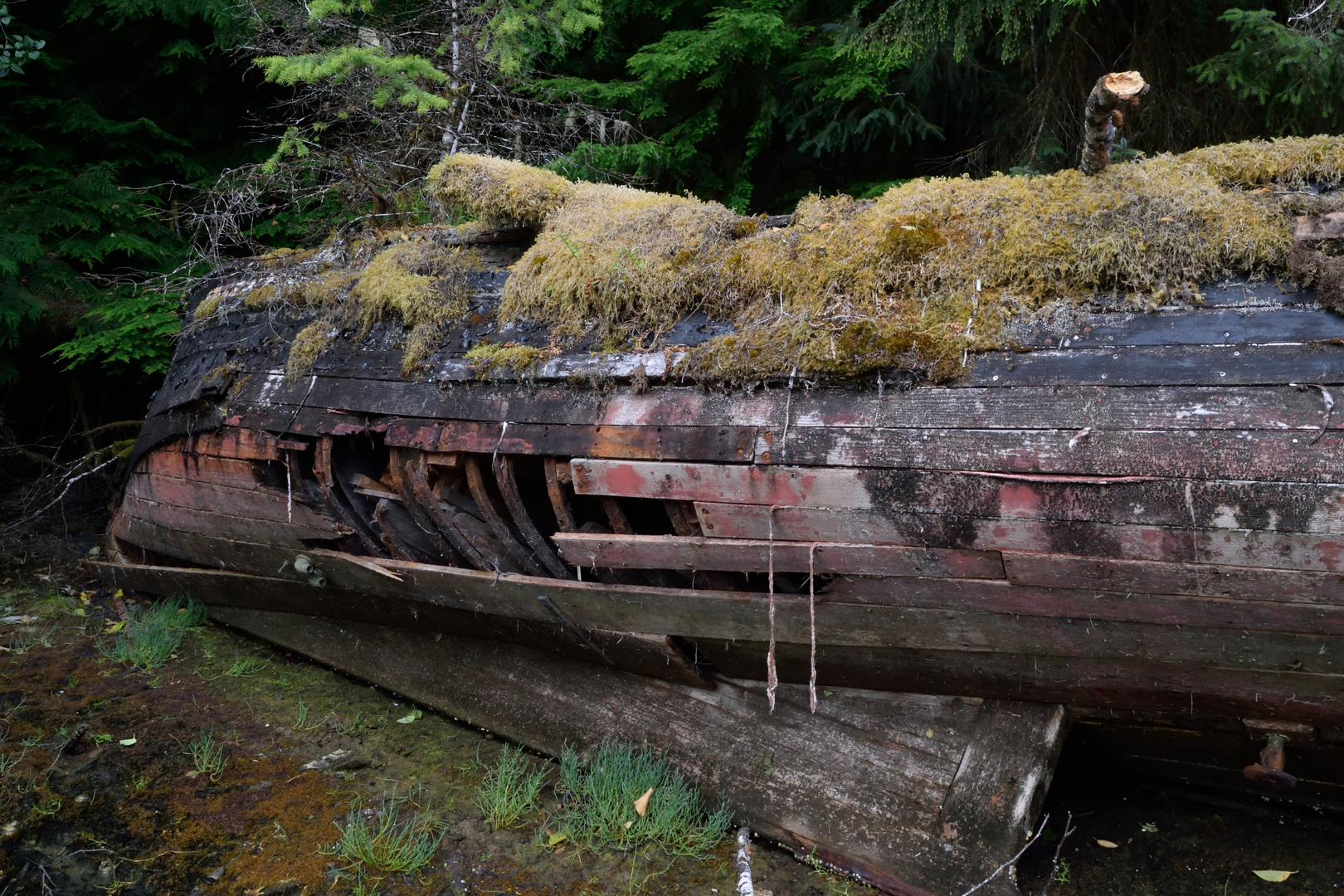
We walked around the forest looking for places to camp. We found the “Green Throne” built by BC Marine Trails. We prided ourselves in being one of the first few people to use it! We found some flat places with nice soft moss among the trees, which was in the area of the foundation of Frigon’s hotel. We didn’t think it was a good place to have a campfire. There were too many “forest fuels” around. We admired the holly and foxgloves—plants not native to the BC wilderness—that have been growing here for over a century.

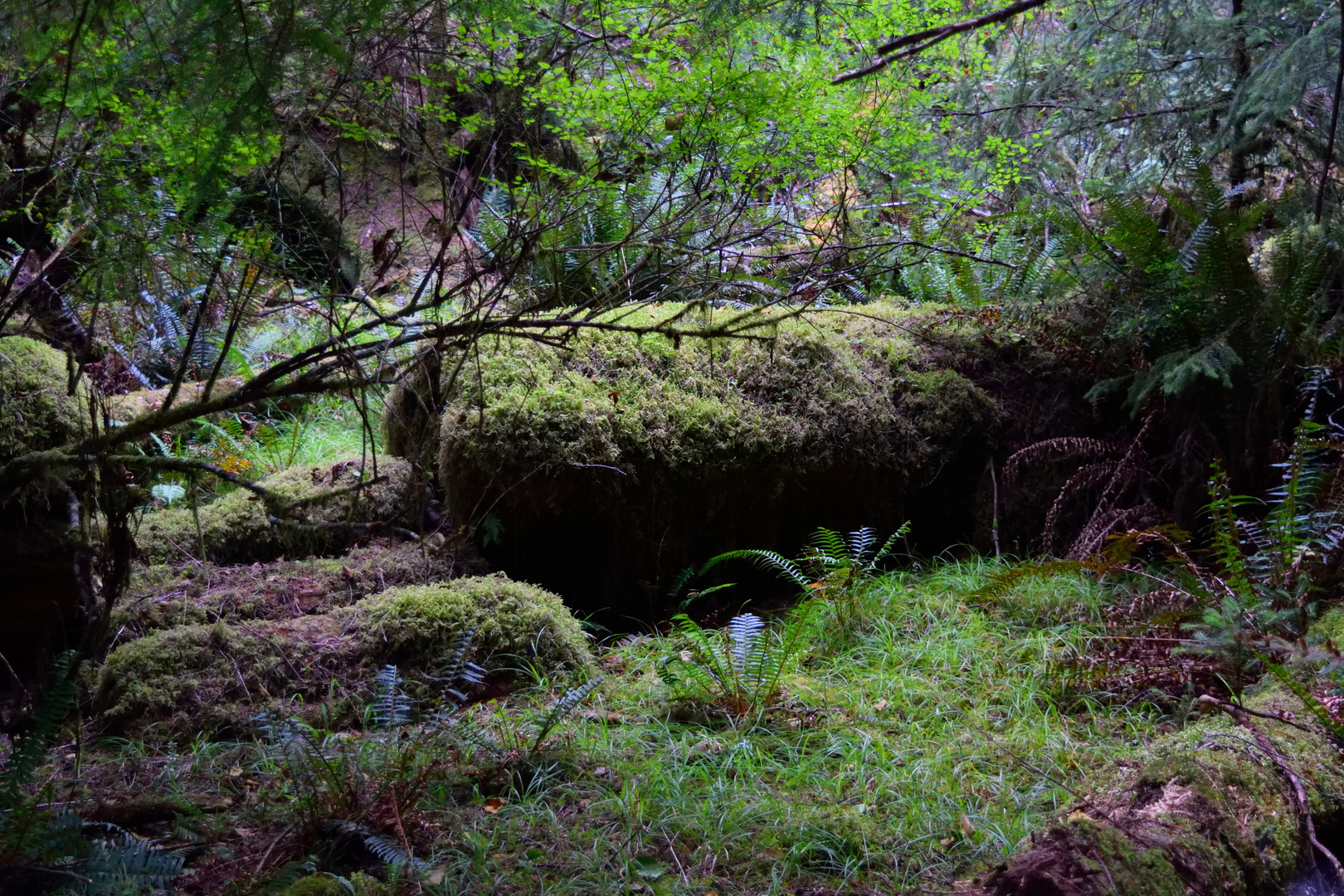

Finally, we went back out to our landing point and noticed a mound protruding out of the water. There was a small spot just big enough for our tent. There were also some rocks arranged in a circle, which was probably previously a campfire. We added a few more and it made a good fire ring. There was virtually no danger of starting a forest fire here!
We later found the hidden cache from BC Marine Trails that advised us to avoid having a campfire. We were going to keep our fire a secret, but I am going to go out on a limb and confess to it. The spot where we had it is probably the only safe spot to have one on the whole island. Having a fire anywhere else could surely lead to disaster. We felt, by leaving a fire ring on the rise, it will deter people from having one in a riskier place.
We set up camp and then took a walk in the forest, taking pictures of the foxgloves and trees and picking huckleberries. We didn’t do much for the rest of the evening except eat, roast marshmallows, drink tea and try to dry out James’ phone.
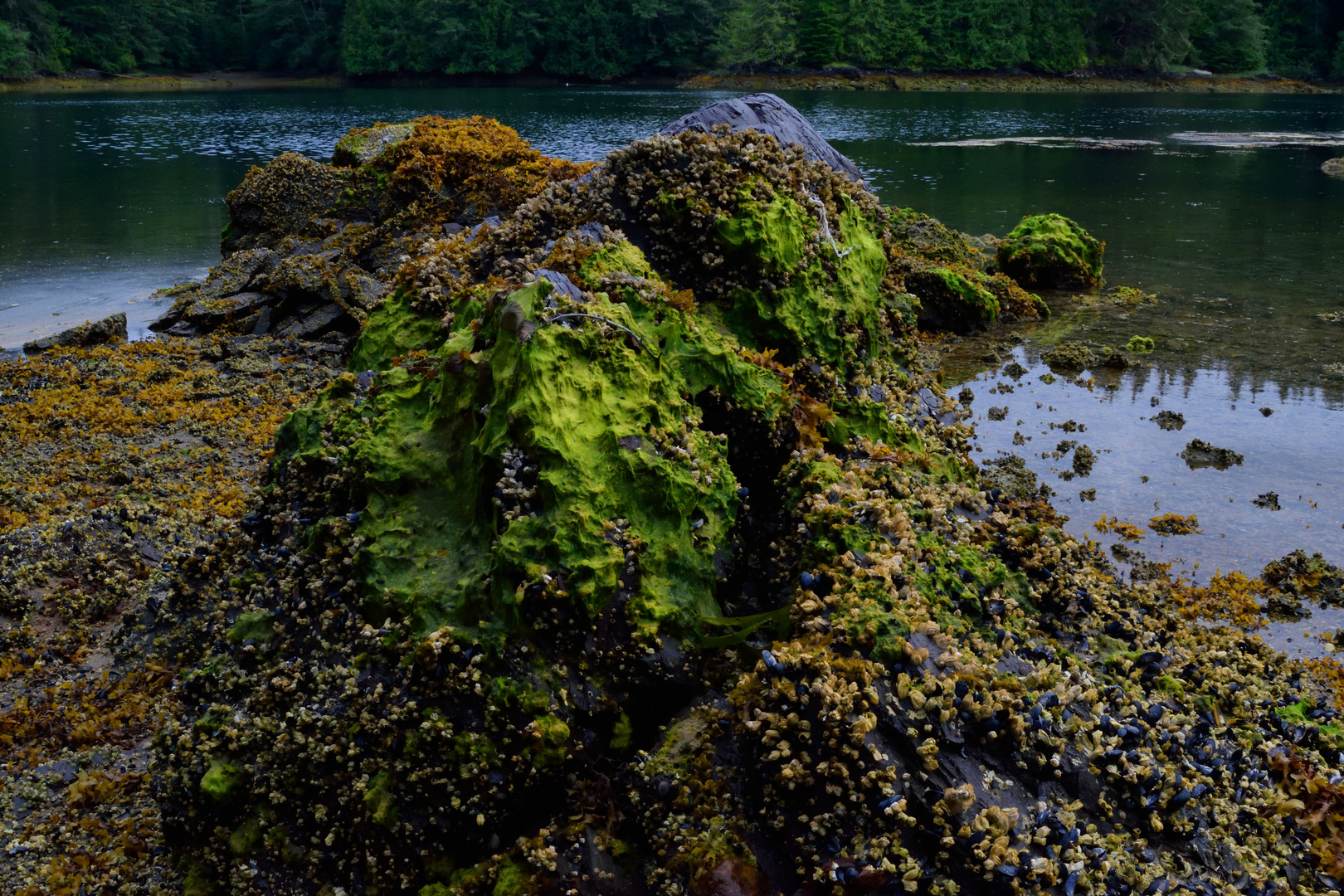
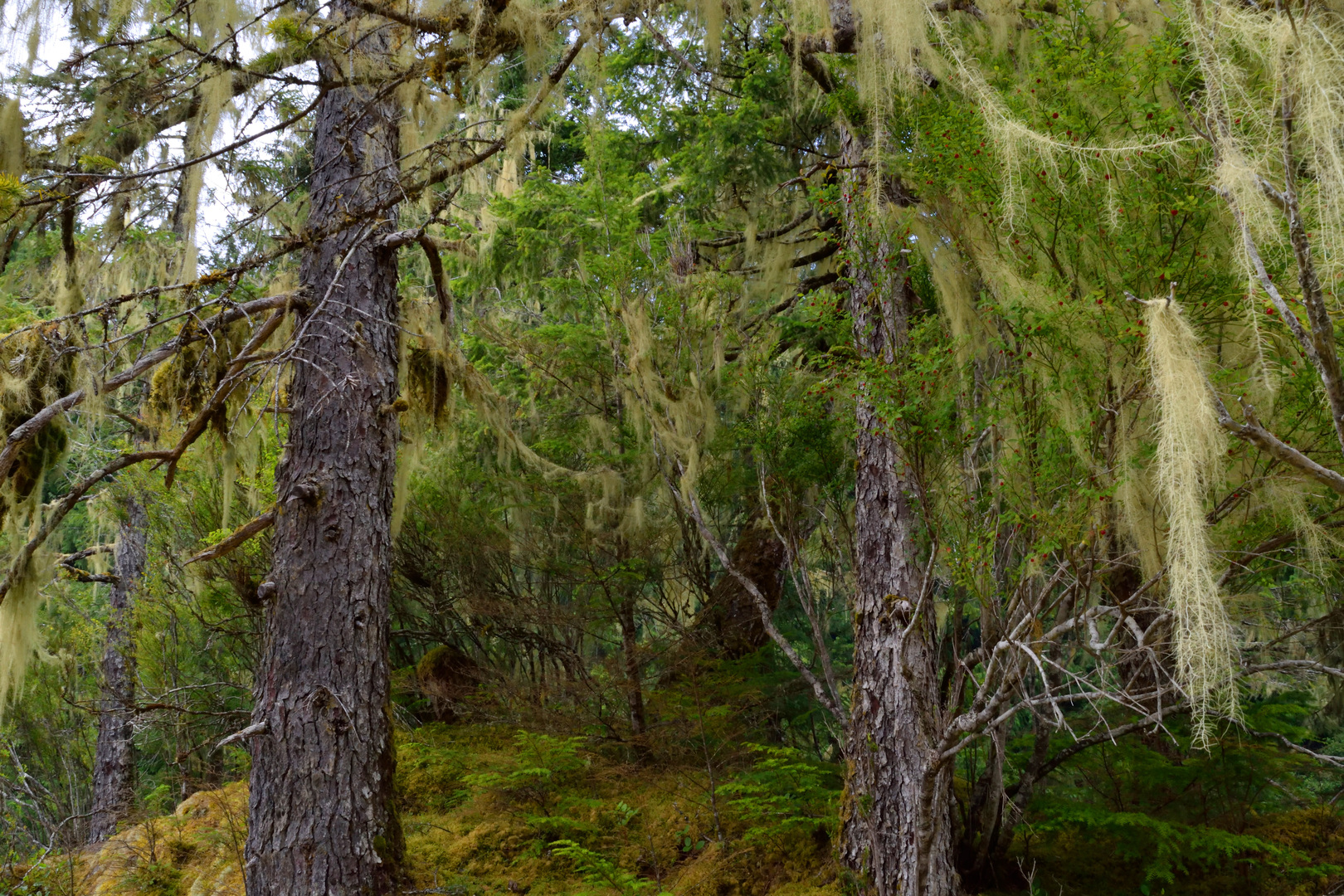
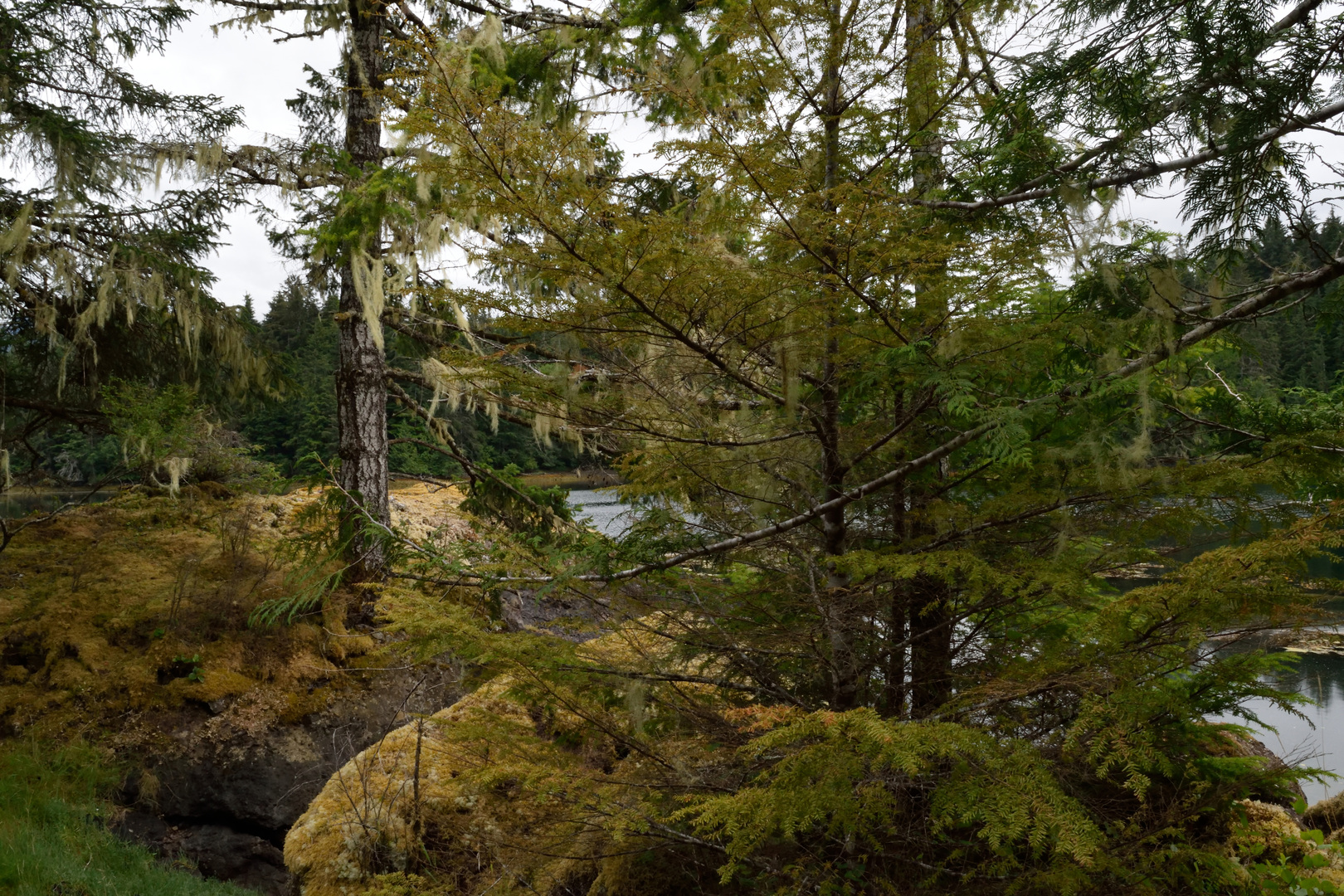
We watched the tide creep up slowly over the course of the evening. We kept trying to figure out if our tent would end up submerged. It was to be an especially high tide: 11ft. We were getting anxious, staying up as late as possible to figure out how close it would get.
I was very tired, because I hadn’t slept much the night before, and James was just tired. We weren’t willing to wait around until 2 am for the high tide point. It turned out we had miscalculated the tide readings and it would not be as bad as originally expected. We didn’t think it would reach the grass—because grass can’t grow under sea water—but we weren’t sure. We thought it might only go to the sea asparagus, in which case our tent, only on grass, should be fine, though it would have been very close.

We ended up working ourselves into a tizzy. We decided to move the tent to a higher point just to put the issue to rest. It was too bad because the other spot was so nice and soft and grassy. At the higher spot, we had to sleep on rocks and roots! When we got up in the night, James concluded that we probably would’ve been OK down below.
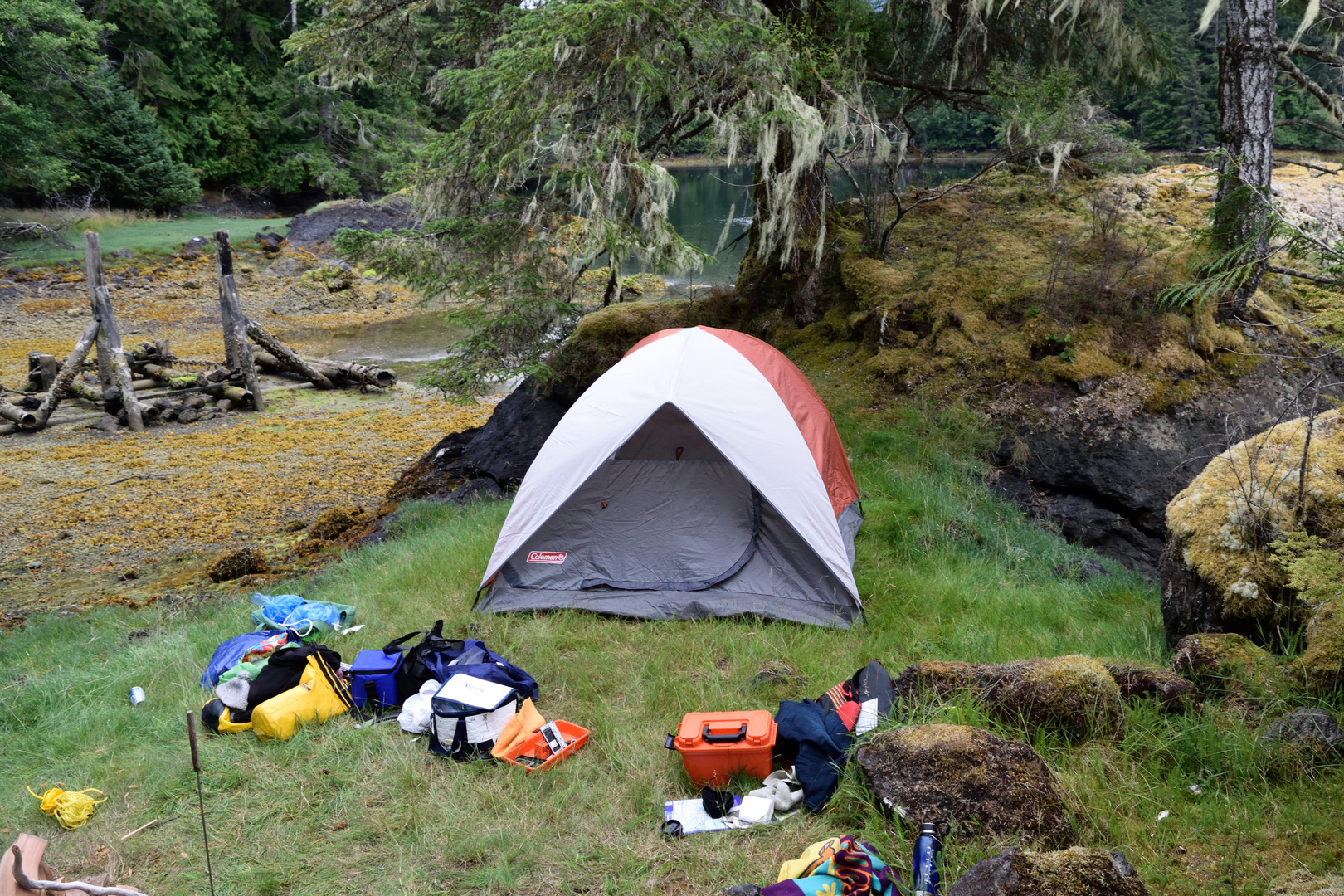
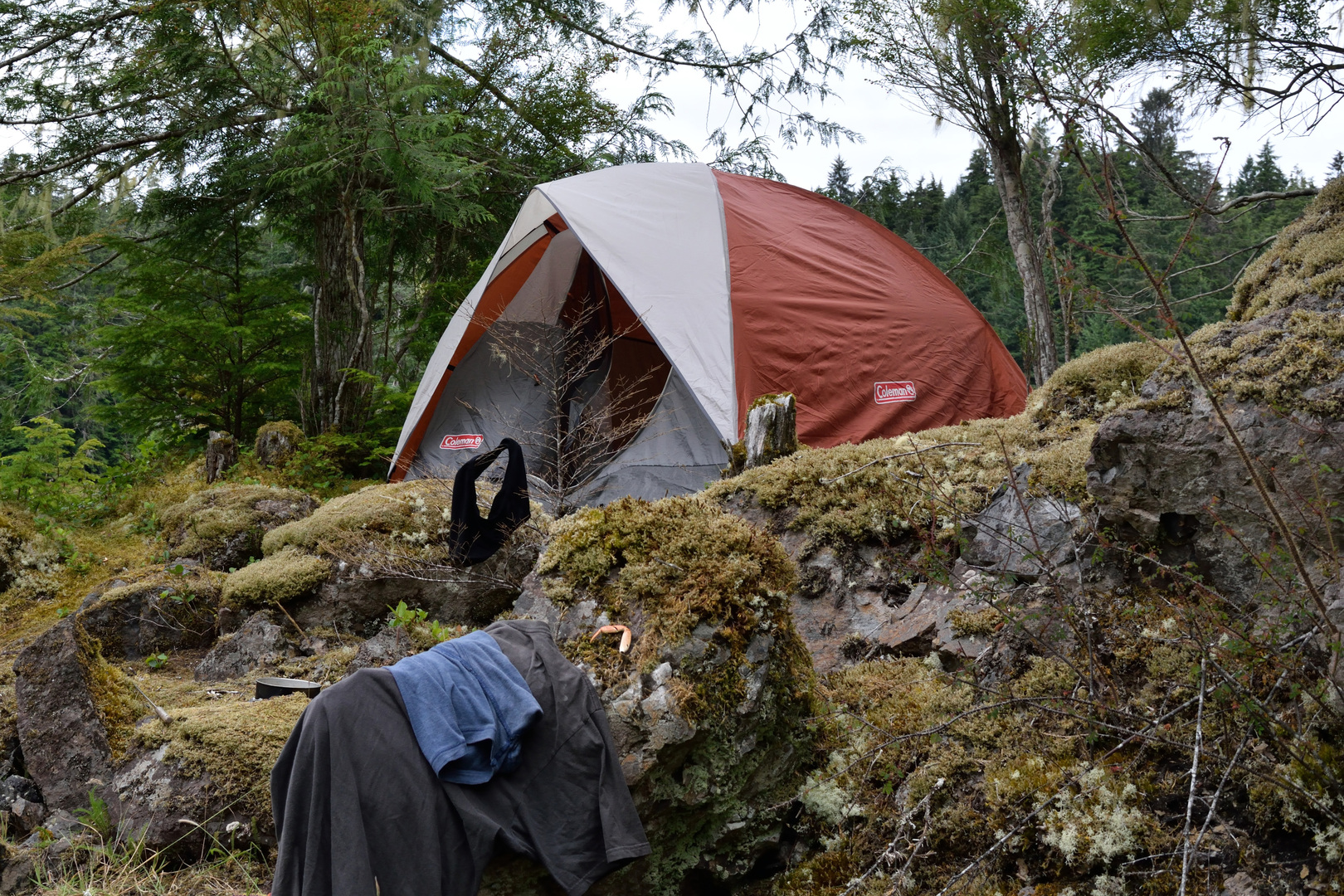
July 20, 2016
The next morning, we were thinking of cancelling our trip to Quatsino. We were late for the flooding tide (this sounds a lot like catching a subway). We decided instead to paddle the last leg of the trip against the ebbing tide at a leisurely pace. We were bound to get there sooner or later.
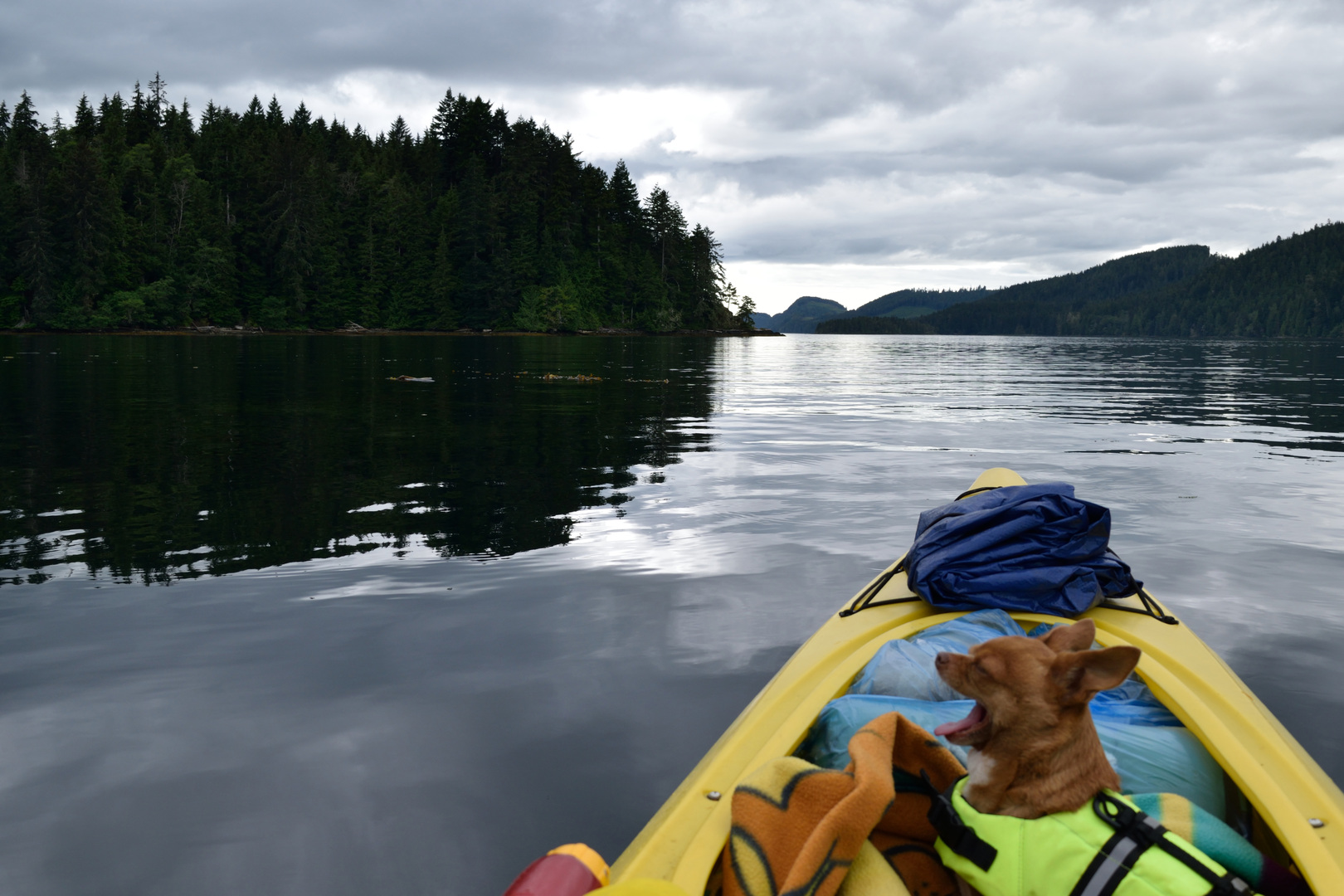
We crossed the sound diagonally, seeing many passing speed boats. We saw a shoreline of houses, many of which were boarded up. Quatsino has seen better days and, I think, will see them again in the future once people discover what a paradise this is.
We cut around an island and a small peninsula. Finally, we came up to a lighthouse and then noticed a cove with a wharf, boats and a concentration of houses. We had finally arrived at Quatsino. We saw St. Olaf’s church and wondered if it was the church in Emily Carr’s painting, The Indian Church. It turned out not to be. When she was painting here in 1930, the church was a school.


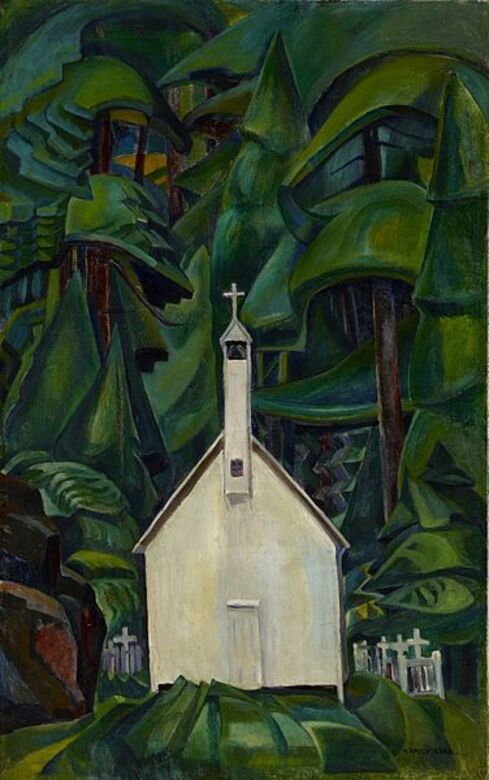
We paddled under the wharf, and, after landing, found ourselves in the company of a community of snakes zipping about hither and thither.
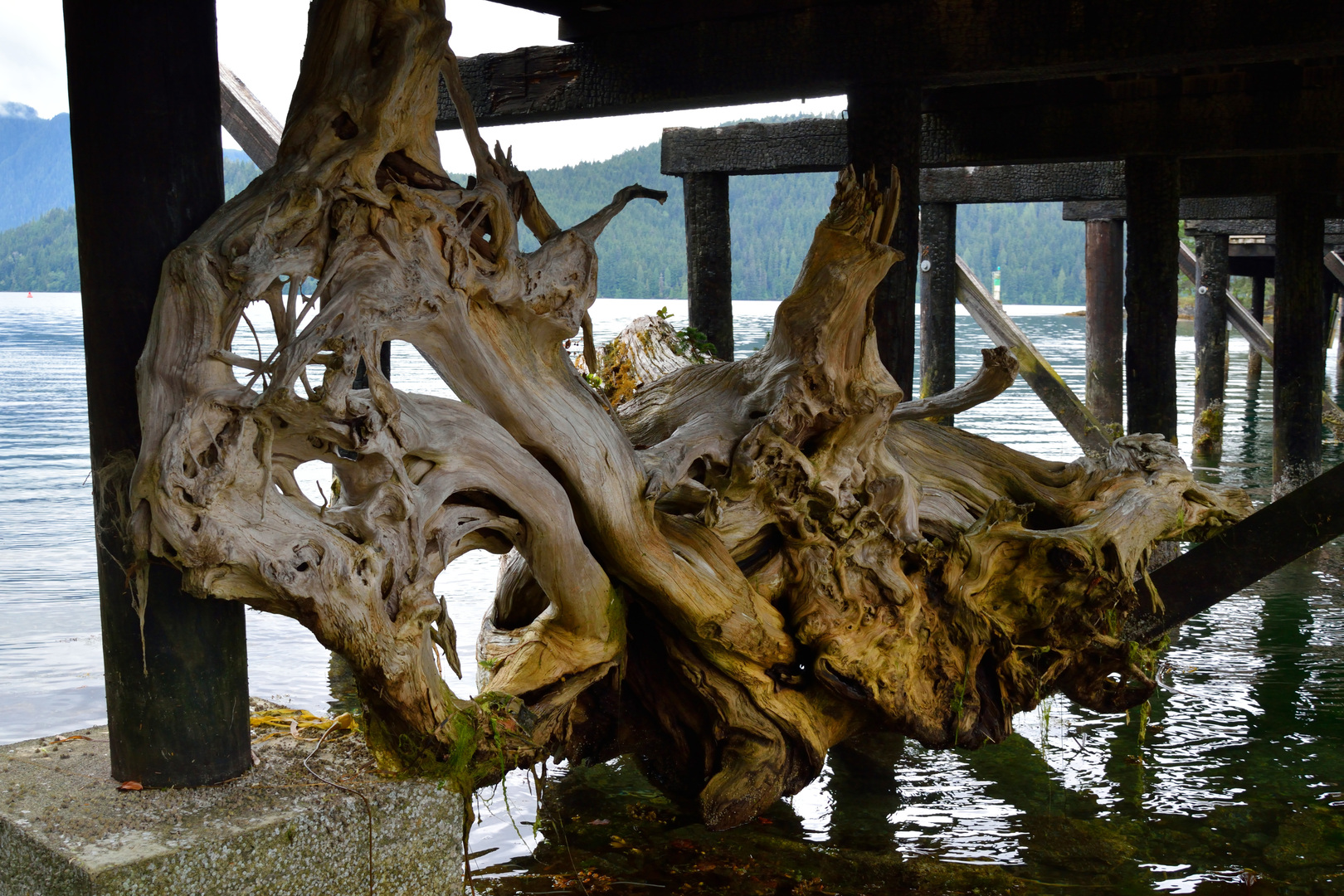
Since I had been living in Port Alice, I had never seen Quatsino, but heard of many heard stories about it. I envisioned it as a place with aging hippies, huge gardens and peacocks running about freely. One of the residents there who has peacocks brought a huge bouquet of peacock feathers to the Legion one day. I ended up getting a few of them from the bartender I babysat for.
Until then, I didn’t have a boat to get to Quatsino and check it out myself. When I finally arrived, it didn’t quite live up to my perhaps over-idealized image of it. I was surprised that it looked a little dreary. This may have been because of the cloudy day. A major tragedy did happen there in 2002, where a father murdered his six children and then set his house on fire. Even further back, there was a domestic murder suicide. Perhaps the causes and effects of such events leave subtle signs and suggestions on the face of a village, the same way a person who has suffered a great loss has a permanent look of sadness in their eyes. In spite of that, I see that, one day, maybe 50 or so years from now, Quatsino will be a colourful little village (maybe even with the peacocks roaming freely) that will attract many visitors from around the world. It already does to some extent. Perhaps the Quatsino I was seeing in my mind before was a Quatsino of the future.
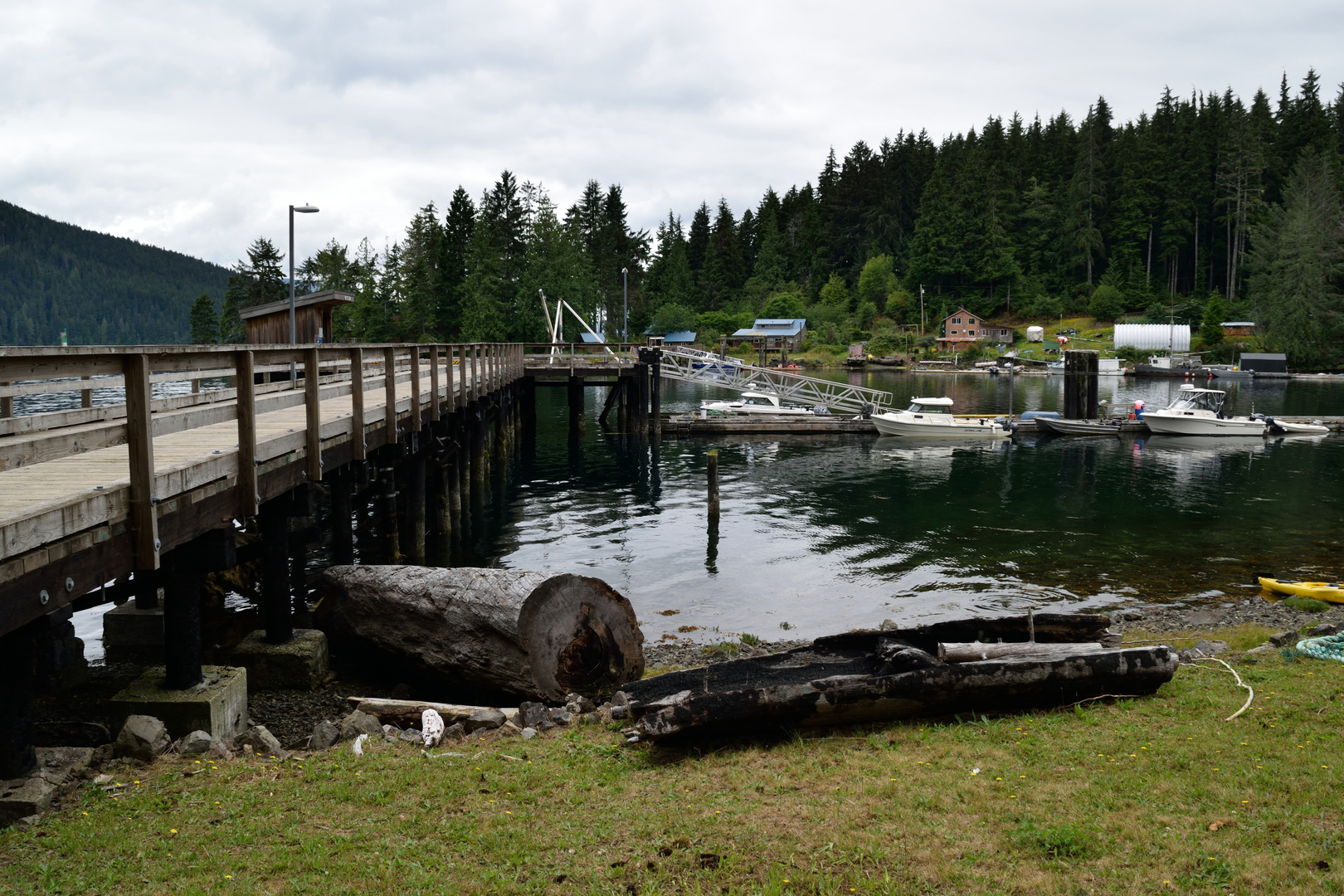
Quatsino is a very different way of life. To get anywhere, you need a boat. The community once had an opportunity to install a road, but they voted against it. Although I tend to think of Port Alice as remote, residents leave Quatsino for Port Alice to do their shopping and have a bit of social life and “culture.”

We went straight to the Museum, which looked like the only thing open. We met the curator, Gwen Hansen. I asked her about Ed Frigon, and she led me to a filing cabinet. I read stuff while she and James conversed. Finally, feeling overwhelmed, I asked if I could get copies of the files.
A bunch of people came in who looked very Scandinavian. A very tall guy with a Scandinavian accent pointed to something on the wall and asked what it was. Gwen said it was a sasquatch comb and everybody laughed. Gwen later told me it was a herring comb, but I was still confused. I had to ask James to enlighten me. As it turns out you sweep the comb in the water, catching herring and then throwing them into your boat.
Chloe suddenly started whining hard. James and Chloe took leave of the museum. It turned out Chloe needed to take a really big poop! We were thankful that she didn’t take a dump in the museum! From then on, we resolved to always listen to Chloe, as she usually whines for a good reason (except when she wants extra treats).
We checked out St. Olaf’s church. James was just going to peek in the windows to see what’s inside. I had a more novel idea: I opened the door! It is amazing that there are still places on this planet that don’t have to be under tight security! We went inside, signed the register and took a few pictures of this tiny simple church that was originally the colony’s first school.
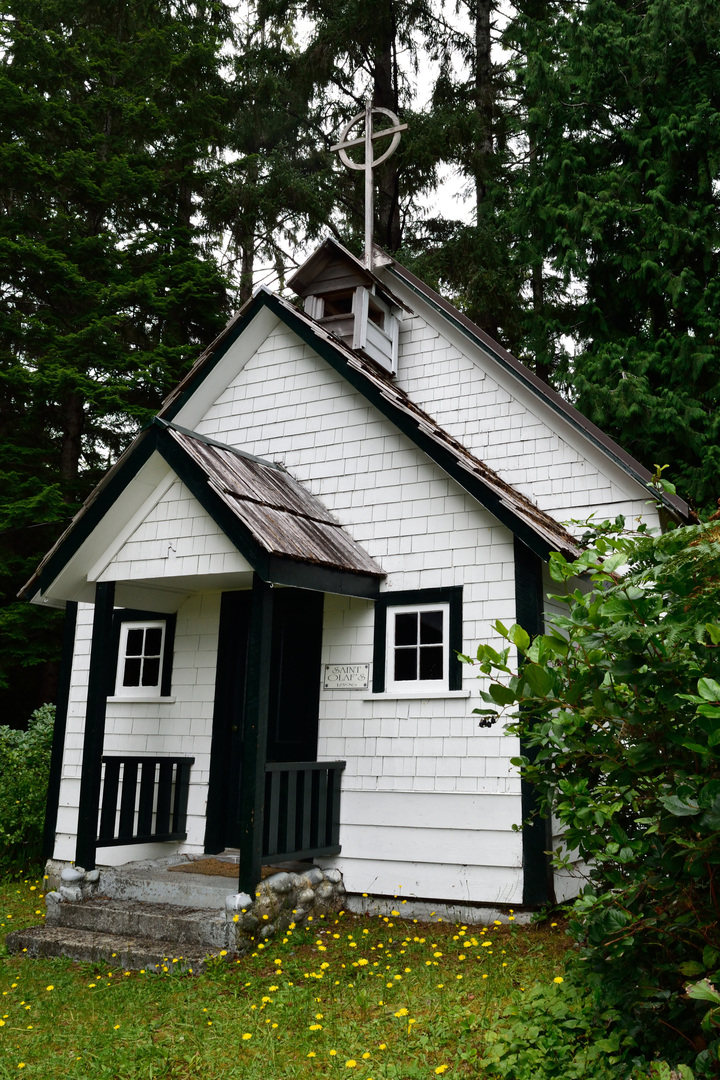 St. Olaf’s Church
St. Olaf’s Church

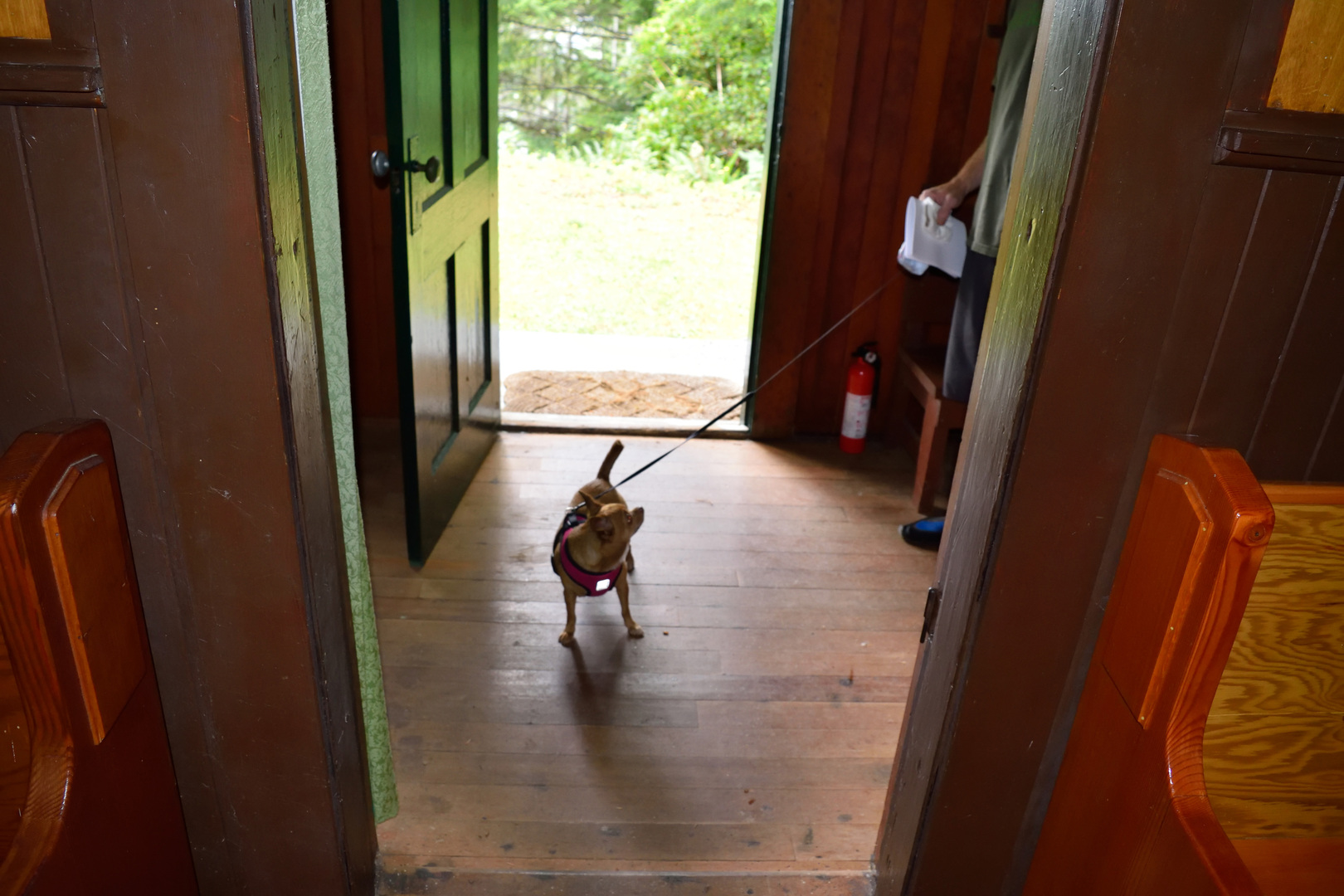
Back at our launch point, we sat and had a snack and took pictures and videos of the snakes. It is amazing that snakes can be so beautiful! And fast! In a place where time moves so slowly, it was odd to see something move like it was late for a very important meeting!

For the trip back to Atkin’s Cove, I was back in Tigger and James in Eeyore. We paddled over the sound surprisingly fast. We took only 15 minutes to cross it. The snakes must have given us some of their energy.
 Kelp bed by Quatsino
Kelp bed by Quatsino
 Going from Quatsino to Atkin’s
Going from Quatsino to Atkin’s

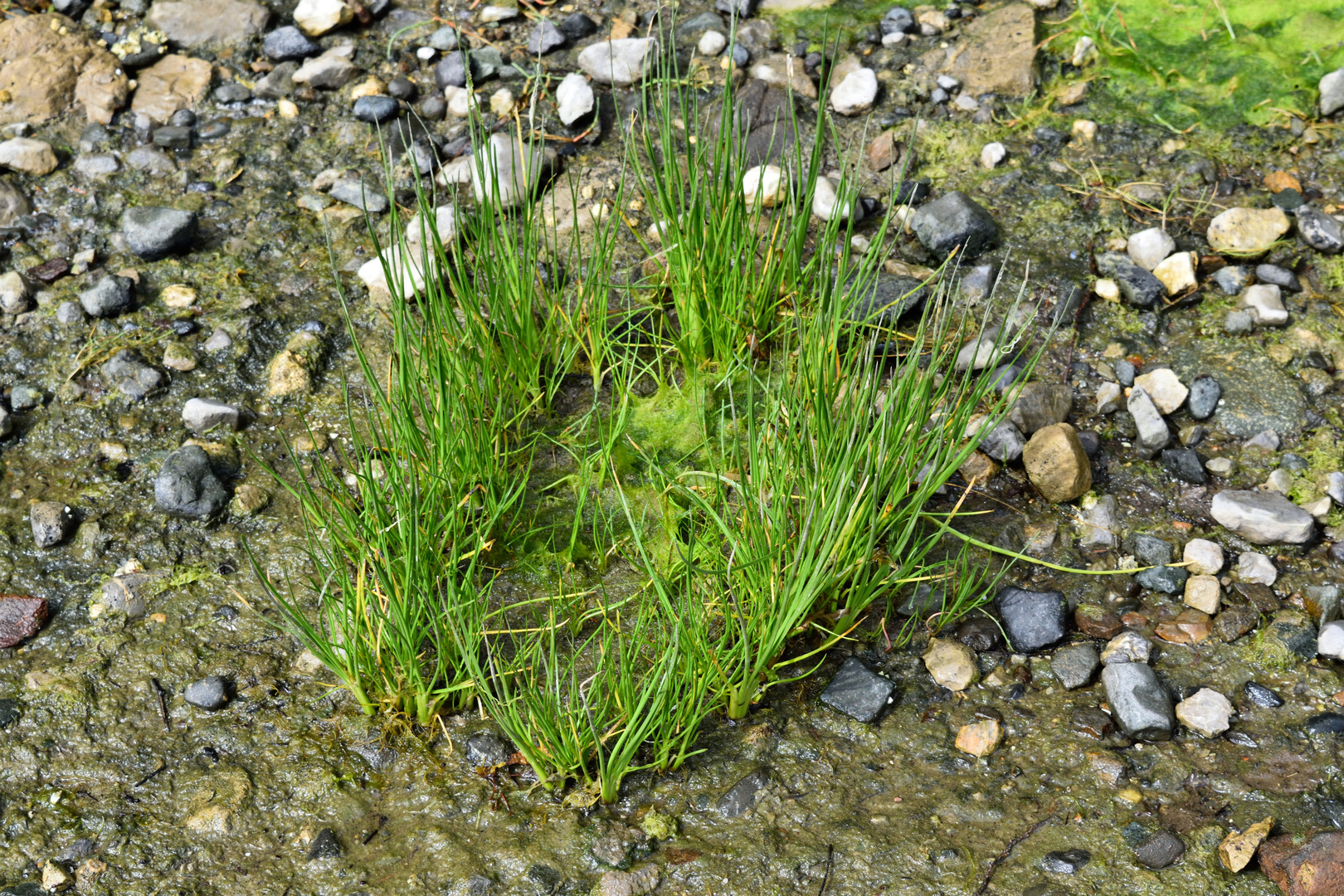

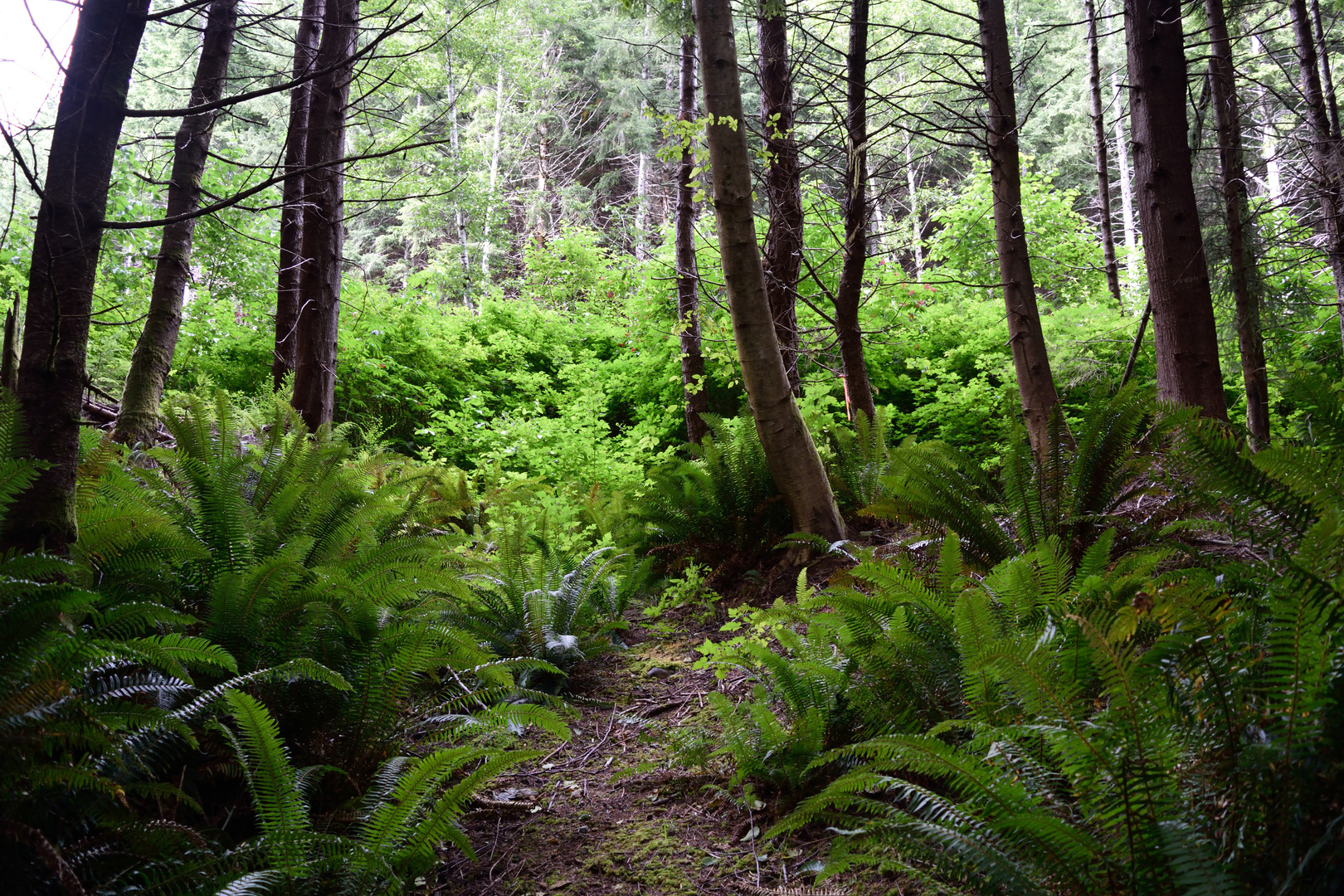
 Truck with kayaks
Truck with kayaks

James may have lost his phone—and his contacts—but I also lost the starfish picture. I had hoped that it ended up on the Cloud, but it was not the case. At home, James checked out a few tricks on the internet but, alas, the phone was pronounced pooched! He phoned Telus and, luckily, only had to add on another $1OO spread out over his payments for his old phone to get a similar new one.
We had a chat about the various ways people we knew have lost cell phones. One person lost their phone in the toilet! Another had to get a professional diver to retrieve theirs from the ocean and it ended up not working anyway! My son goes through a lot of phones too, but he tends to be a screen breaker. We concluded that cell phones are meant to be destroyed, probably because they are carried everywhere. It is one of those unintentional (or maybe intentional?) schemes that keeps the telecommunications industry booming!
